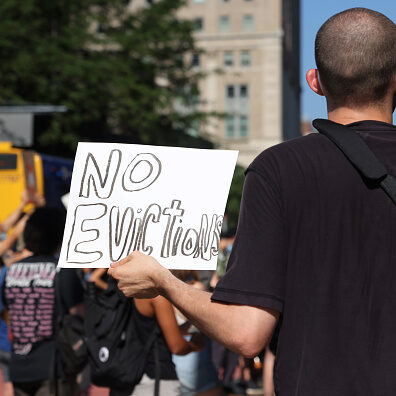The COVID-19 pandemic has damaged virtually all aspects of life, and housing stability is one major casualty. At its peak in summer 2020, the pandemic put upward of 40 million tenants at risk of eviction, and while things have improved since then, even conservative estimates count 2 million tenants at risk of being evicted over the next few months. In Alabama, more than 40 percent of renters fear eviction by year’s end. And the brunt of both the virus itself and the resulting housing instability has fallen disproportionately on communities of color. As a result, cities have been trying a variety of eviction diversion strategies to stymie this crisis and remain eager to explore new solutions.

While upstream solutions such as increased affordable, safe housing and comprehensive landlord-tenant law reforms are ultimately the best form of eviction prevention, there must be interventions for tenants already at high risk of being evicted.
A right to counsel for tenants facing eviction is effective, ensures the use and enforcement of other interventions such as rent assistance and eviction moratoria, and addresses starkly uneven power dynamics and longstanding racial disparities. Where a city or state has enacted a right to counsel, qualifying tenants (either all tenants or those meeting certain eligibility criteria) are provided or appointed a lawyer for their eviction case at government expense, as happens in criminal cases.
The eviction landscape reveals the urgent need for diversion, as well as why the right to counsel is an essential part of any diversion program: Prior to 2020, the Eviction Lab found that there were roughly 3.6 million eviction filings in a typical year. Evictions put these millions of tenants in jeopardy of homelessness, loss of child custody, unemployment, mental and physical health problems, loss of possessions and even incarceration (which is common for people experiencing homelessness).
Yet available data shows that only 3 percent of tenants have legal representation when facing eviction proceedings, compared to over 80 percent of landlords. This is unsurprising because where there is no right to counsel, the available assistance is limited primarily to heavily underfunded legal aid programs. The disempowerment and bewilderment felt by unrepresented tenants navigating a complex legal system helps explain the high percentage of tenants who do not respond to the eviction complaint or appear in court, which is around 50 percent in most places and as high as 79 percent in some.
Tenant Representation Changes the Game:
For one, lawyers identify legal defenses the tenant is likely not aware of: Failure of the landlord to follow the eviction procedures, improper notice of the eviction, illegal rent charges, failure to make repairs, sexual/racial harassment or retaliation, and failure to properly credit rent paid are just some examples. Beyond employing an appropriate defense, tenant lawyers are also extremely effective at negotiating fair terms with the landlords’ attorneys that allow tenants to remain housed.
It is therefore no surprise that the results coming out of right to counsel jurisdictions are stunning: In New York City, 86 percent of represented tenants remain in their homes. In San Francisco, 67 percent do. And in Cleveland, 93 percent of represented tenants are avoiding eviction or an involuntary move.
But even in situations where tenants cannot remain in their home, lawyers can effectively negotiate for more time, a smaller rent judgment and a graceful exit so that the eviction will not be on the tenant’s record. It’s a small wonder, then, that represented tenants who vacate their homes are far more likely to obtain new housing and avoid the “Scarlet E” of eviction.
A right to counsel also helps effectuate other components of eviction diversion programs. The federal rental assistance program’s effectiveness has been hampered by delays (some of which is due to assistance programs needing to be created from scratch), as well as landlord refusal to participate. And while eviction moratoria have been effective, studies have shown that landlords have found ways around them or ignored them entirely, and some housing court judges refused to honor them. Other types of diversion efforts, such as post-filing mediation, have shown to be ineffective without representation. These problems reveal that reforms are only as good as the enforcement available to give them meaning.
Right to counsel is that enforcement: It ensures landlords and courts follow new laws (whether moratoria, rent control, housing conditions or pre-filing requirements) and can improve the performance of programs like emergency rental assistance by helping tenants navigate the process, negotiating, and following up.
Understanding of all of this has reached the mainstream: In just the last four years, 11 cities and three states have enacted such a right, and 10 states introduced legislation for a right to counsel this year alone. Moreover, players from across the spectrum have drawn attention to the issue, including the Federal Reserve, the United Way, the Washington Post Editorial Board, state high court justices, the ACLU and the Legal Services Corporation. They have seen the evidence that right to counsel is an effective intervention and that now is the time to act.
Cities that are worried about the expense of providing a right to counsel for tenants should be reassured on several fronts. Studies have repeatedly shown that a right to counsel saves cities far more money than it costs by reducing government expenditures on services such as homeless shelters, foster care, and emergency health care. But additionally, several streams of federal emergency relief funds can support a right to counsel — and dozens of cities and states have already used them for this purpose.
First, the Emergency Rental Assistance Program (ERAP) provided jurisdictions with nearly $48 billion to assist tenants behind on rent, and up to 10 percent of the funds can be spent toward “housing stability services,” which the Treasury Department noted includes legal representation. An August press release from the Department of Housing, the U.S. Treasury and the Attorney General urged jurisdictions to use ERA funds to “support the right to counsel and eviction diversion strategies.” In fact, starting this month, jurisdictions risk losing ERAP money they have not committed, and a contract with a legal services organization counts as a commitment of funds.
Second, the American Rescue Plan Act provided states and local governments with $350 billion in State and Local Fiscal Recovery Funds (SLFRF), and the U.S. Treasury has specified that tenant legal representation is an allowable use for those funds too.
Evictions are a scourge to cities, and a crisis that has been around for far too long. By embracing a right to counsel alongside other necessary diversion efforts and taking advantage of the federal funding available right now, cities can increase housing stability and ensure we do not return to the unjust eviction system that existed before the pandemic.
Learn More
Want to learn more about right to counsel? Watch our webinar, Expanding Access to Legal Representation: Right to Counsel & Eviction Prevention, to hear from cities about their journeys to expand equitable access to legal representation.

About the Author:
John Pollock is a Staff Attorney for the Public Justice Center who has served as the Coordinator of the National Coalition for a Civil Right to Counsel (NCCRC) since 2009.








